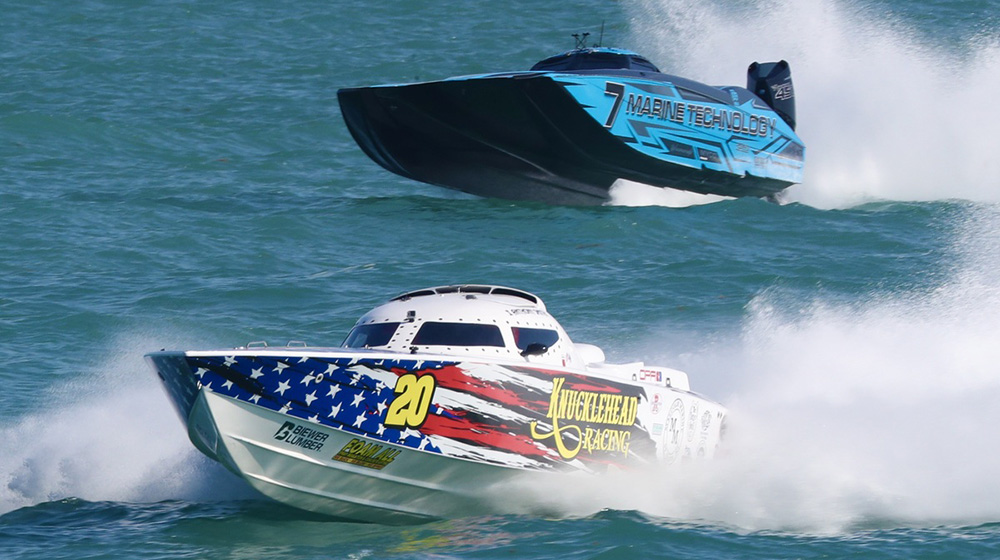Auto racing is not the only sphere with an F1 Class. Each class of modern inshore powerboat racing (aka circuit racing) is designated as a Formula class, with a number based on the level. Each of these levels has its own set of regulations that dictate not only the design of the boats and engines, but also the rules of the competitions. The elite class is known as Formula 1 (F1). Here is an overview of this premium version of the exciting sport of inshore powerboat racing.
What Is the Formula 1 Powerboat World Championship?
The main competition for this elite class is the Formula 1 Powerboat World Championship. Hosted by the Union Internationale Motonautique (UIM), the international governing body of powerboat racing since 1922, and promoted by H2O Racing, the race is often referred to as F1H20.
Participants compete on inshore circuit tracks in races that generally last about 45 minutes. These circuits are usually marked off in a section of water, often in a dock, lake, river, or sheltered bay. The formation of the grid is decided through qualifying periods. During each race, automated timing equipment records each competitor’s performance, and these times designate the final allocation of championship points.
History of Formula 1 Inshore Powerboat Racing
Although UIM held the inaugural Formula 1 Championship in 1981, David Parkinson, a PR manager, first came up with the idea of a single unified inshore powerboat racing championship in 1978. One of Parkinson’s clients, marine engine manufacturer Mercury Marine, offered its support, provided he could lay the groundwork for the series. Referred to as the Canon Trophy, this original concept was sponsored by Canon Inc., another of Parkinson’s clients.
Mercury was in the midst of an engine development battle with its main rival, the Outboard Marine Corporation (OMC). This competition led to the development of the incredibly powerful 3.5-liter V8 engines and the creation of the OZ engine class. Each company offered several drivers free OZ-class engines to promote its new products.
These OZ engines differed significantly from the ON engine, which was the standard at the time. Boats with OZ engines were more powerful than ON boats, and the OZ models easily dominated in races. In 1980, 28 drivers signed a petition to outlaw OZ boats, which led to the formation of the Formula ON Drivers Association (FONDA). In 1981, UIM decided that OZ and ON classes would have their own championships.
Initially, both championships tried to call themselves Formula 1 as a marketing tool to position themselves as the elite class of inshore powerboat racing. However, sponsor John Player & Sons decided to support the OMC’s OZ championship, which gave OZ advantages in speed, technology, and marketing. UIM eventually decided to award the Formula 1 designation to OZ, making the title official. The ON class was given the title of World Grand Prix, but this series was quickly overtaken by the more powerful Formula 1 World Series.
Formula 1 Powerboat Racing Structure
The structure of Formula 1 powerboat racing makes it easy to enjoy the races as a spectator. The races use a fixed points system derived from Formula 1 car racing, with the top six finishers awarded 9, 6, 4, 3, 2, or 1 point based on where they finished.
Formula 1 racers compete in a Grand Prix-style event, with races being held across the globe during each season. Each race track is approximately 350 meters and with multiple turns, and most races last approximately 45 minutes. Modern F1 boat racers can reach speeds of up to 155 mph.
The Boats of F1 Inshore Racing
F1 racers compete in tunnel hull catamaran boats. Approximately 20 feet long and 7 feet wide, these boats weigh roughly 860 pounds, including 260-pound engines. Materials like carbon fiber and Kevlar are used to keep the boats low-weight.
These boats are capable of reaching high speeds due to the tunnel hill design, which creates an aerodynamic lift effect. A wing is formed between the deck and the surface of the hull, which increases lift and decreases drag. When traveling at top speed, only a few inches of the catamaran remain in contact with the water.
Mercury Marine is still the major player in F1 racing boat engines, as modern inshore powerboats are powered by the company’s V6 two-stroke engine, which burns 100LL Avgas at 32 gallons per hour, generating more than 400 horsepower at 10,500 rpm. This engine can take a boat from 0 to 62 mph in less than two seconds and allows the boats to reach maximum speeds of 155 mph.
All boats are also required to follow safety regulations, including the installation of a protective crash box.

